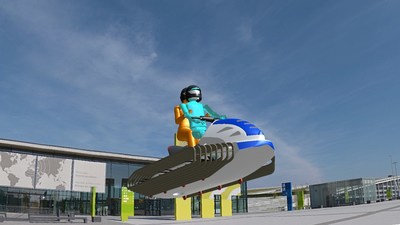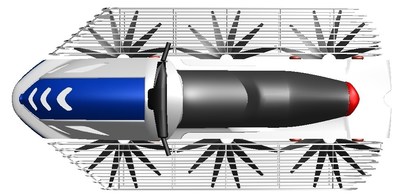Delaware
Blainjett Discovers a Novel Lift-Rotor Configuration While Designing Propulsion for a Hoverbike
LEWES, Del., Jan. 5, 2022 /PRNewswire/ -- Blainjett Aviation, an innovative aerodynamic propulsion technology startup, today announced it has conceived a novel lift-rotor configuration which promises to deliver significant efficiency and thrust improvements for eVTOL and other vertical-lift designs. Blainjett's discovery was made through work on a joint venture with Horizon Aeronautics, refining the design of Horizon's Hoverbike, a proposed short distance commuter vehicle.
With outer mold lines and a size similar to a jet ski, Horizon was in search of a compact, powerful thrust-generating system for its hybrid/electric hoverbike. Horizon turned to Blainjett after learning about its patented Dynamic Variable Pitch (DVP) technology which enables rotorcraft to generate vectored thrust (and thus higher speeds) while in level, forward flight without resorting to large rotating assemblies like a tilt-rotor.
Instead of changing the angle-of-attack of a helicopter or eVTOL rotor to create forward thrust, Blainjett's DVP concept changes the pitch of the rotor blades through one half of the rotor arc using a proprietary cam and flexible plate mechanism. The concept suits Horizon's urban-centric hoverbike well since the very-low flying vehicle needs to remain level to accommodate its riders.
Given the task of conceiving a thrust generation system for the 9-foot long, four-foot wide hoverbike, Blainjett president, Cary Zachary, began evaluating a series of digital models pairing rotor configurations with an electric powertrain.
"Horizon Aeronautics has real space and power constraints," Zachary explains. "When we realized that we could nest the lift rotors in a certain way that maximizes space available and combine their placement with our vectored thrust concept, we knew we had something unique."
Zachary came up with a design that situated rotors in-line along the belly of the hoverbike. Rather than having each rotor fully exposed as on a helicopter or eVTOL, he decided to enclose half of each multi-blade rotor within the body of the hoverbike. The idea employs DVP, increasing blade pitch as rotors pass through the exposed outer-half of the spinning rotor arc and returning rotor pitch to neutral as they pass through a fairing within the hoverbike body.
In effect, lift and vectored thrust are generated by one-half of the rotor. This novel hemispherical lift-rotor configuration produced surprising results. Compared to complex many-rotor or ducted fan designs, Blainjett achieves greater thrust and power distribution efficiency with a small number of larger hemispherical rotors.
"It turned out when we compared our thrust output and efficiency to ducted fans and smaller rotors we were 2-3 times more efficient with 2-3 times more power density while fitting in the same available space. There's also a reduction in aerodynamic drag in forward flight."
Horizon Aeronautics plans to roll out a fully functional prototype integrating Blainjett's patent-pending hemispherical rotor design in late 2022. As the joint venture proceeds, Blainjett is embarking on additional proof-of-concept work for hemispherical rotor application in the burgeoning Advanced Air Mobility market.
"Our ambition in the future is to perfect this innovation for Horizon Aeronautics as well as to license it for applications outside the specific ground-effect hover-vehicle market."
About Blainjett
Founded in 2016, Blainjett Aviation is a privately-held advanced aerodynamics design firm with a focus on rotary-wing projects and novel concepts for efficient, affordable flight.
CONTACT:
Cary Zachary
President
Office: 302-827-4020
[email protected]
www.blainjett.com
![]() View original content to download multimedia:https://www.prnewswire.com/news-releases/blainjett-discovers-a-novel-lift-rotor-configuration-while-designing-propulsion-for-a-hoverbike-301454283.html
View original content to download multimedia:https://www.prnewswire.com/news-releases/blainjett-discovers-a-novel-lift-rotor-configuration-while-designing-propulsion-for-a-hoverbike-301454283.html
SOURCE Blainjett Aviation


